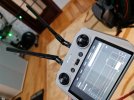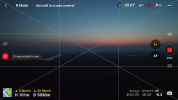I agree with the lower frequency being better for distance & obstruction resistance, but it's also slower for data transmission rates as I understand; if I'm incorrect, please let me know.
The USN use/used ELF (extremely low frequency) for communications with their submerged (ballistic missile) submarines, even on the other side of the world. Those frequencies can even penetrate the Earth's crust to transmit signals, albeit at a glacially-slow rate.
Most cordless phones (I mean, household telephones connected to a landline, not cellphones) use either the same 2.4 or 5.8GHz band as most drones. Although, the range is very short in comparison to some cordless phones in the past which used to use the 900MHz band. I still have 1 of those type cordless phones, which uses the 900MHz band & DSS which gives me a good connection even at 5-6 blocks distance in a suburban environment.
I expect a similar relationship with radio frequencies for drones in the higher bands. With all the data flow between the drone & the controller, I suspect the higher frequencies are needed.











